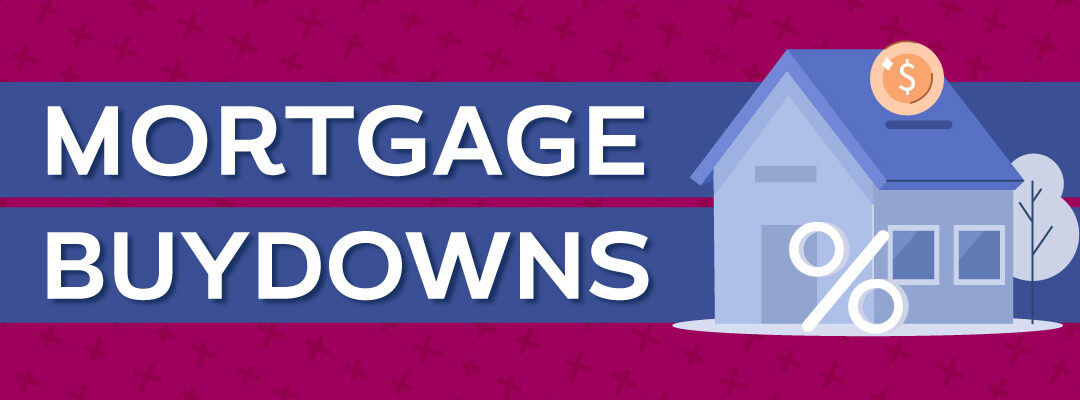You Don’t Need to Pay High Interest Rates! Welcome to “Rate Buydowns”!
Interest rates are double what they were a year ago, but you can get an interest rate that is 3% lower than current rates. Do you like to buy a home or investment property right now, but these high-interest rates are holding you back? There are things you need to know that can do to beat those high-interest rates so you can get into the home of your dreams with some creative but simple financing options!
How to save money when buying real estate with something called a “buydown”? When you borrow money from a bank to buy a house, you must pay back the money with something called “interest”? Those interest rates are double what they were a year ago and it’s making it harder to afford the home of your dreams. The good news is that the higher interest rates have driven down home prices and when we couple this with interest rate buydowns, homes that cost so much a year ago is now more affordable! A buydown is a special way to make your interest rate lower, at least for a little while.

Types of Rate Buydowns
There are several different types of buydowns, but we’re going to talk about three of the most important ones for real estate buyers. First, is the TEMPORARY RATE BUYDOWN. This is commonly referred to as a 3-2-1. In this type of buydowns, typically the Seller or Builder, in buying new construction, will pay the fees associated with this buydown! With this type of buydown, the interest rate is lowered by three percent in the first year, two percent in the second year, and 1 percent in the third year. In Years 4 to 30 the loan will be adjusted to whatever the mortgage rate would have been today. This means that your monthly mortgage payments will be lower in the beginning, but they will go up a little bit in the second, third, and fourth years and then remain fixed for the rest of the loan term. The idea is that you can use that time to save some money and then refinance your mortgage later to get a better interest rate. For example, if the interest rate would have been 6.5% today, with a 3-2-1 program, it would be 3.5% for the first year, 4.5% for the second year, 5.5% for the third year, then 6.5% starting in year 4 for the remainder of the loan. In the discussion about the state of the economy and housing market, most experts are expecting rates to decrease, which means now is the perfect time to consider a buydown! There are variations on this loan like 1-0, 2-1 or 3-1 buydowns as well. The good thing about temporary buydowns is that they can make your monthly mortgage payments more affordable, at least in the beginning. The downside is, nobody can guarantee that rates will be down around the time you want to re-finance. This is undoubtedly a loan product to consider if you are planning on keeping the property for only a short time.
Second, is the PERMANENT INTEREST RATE BUYDOWN. Which is when the interest rate is lowered permanently. You’ve probably heard of the term “discount points” but might not be sure what it means. Discount points, also referred to as mortgage points or prepaid interest points, are a one-time fee paid upfront. Each point that a borrower pay is equivalent to 1% of the loan amount. Thus, if the interest rate is said to be 6.2%, you can pay a fee towards your loan and lower your interest rate down to say 5.2%. You may have heard of the term “basis points.” One basis point equals 1/100th of 1%, or 0.01%, so one hundred basis points equal 1%. Costs vary with Permanent rate Buydowns, but typically expect to pay about 1% of the home purchase price upfront to get this interest rate buydown. If you are a buyer who has enough for a 20% down payment with money left over, and you plan on keeping the property a long time, this is a great strategy for you. If you need to decide between making a 20 percent down payment and buying points, make sure you run the numbers as a lower down payment can mean also paying for private mortgage insurance (PMI), which could cancel out the benefit of buying points for a lower interest rate. Buying points to lower your monthly mortgage payments may make sense if you select a fixed-rate mortgage and plan on owning the property after reaching the break-even period, which is the time it takes to recoup the cost of buying the points. Payments beyond your break-even point are where you really start saving. Sellers may also offer to buy down a buyer’s mortgage to incentivize the buyer to purchase their home. In these circumstances, the seller will make the one-time payment and deposit it into an escrow account or pay for points over the entire loan term as part of seller concessions. Of course, this probably won’t happen in a Sellers’ Market.
Third, is the ADJUSTABLE-RATE MORTGAGE or an ARM. This might be mostly associated as what caused the 2008 crash. The situation back then was that anyone who could fog a mirror could get a loan. Stated Income Loans were common where people would just say they made a certain amount of money, and lenders took them at their word and gave them the loan. The lenders then never explained how the ARMs worked, and that the rates could and would rise after the first year. Plus, many of those ARMs had balloon payments which set the borrowers up to fail. What you want to look for now is a 5/5/2 ARM without balloon payments.
What is 5/5/2 ARM can give you a rate 2-3% lower than a typical fixed-rate mortgage for the first 5 years. At year 5 it will adjust up by a maximum of 2%. So, for example, rates are about 6% today. You can get a 4% mortgage for 5 years. At year 5, it will likely adjust to 6%. So over 10 years, you have a blended average of 5% rate. Again, you can refinance at a lower fixed rate, typically after the first 3 years. So, for example, on a $600,000 purchase, you would pay about $2,300 in Principal and Interest for the first 5 years. For years 6-10 you would pay just under $2,900. On average that would be $2,600 over 10 years.
The 5/5 ARM gives you five years in between adjustments, which allows for more breathing room in your budget for monthly payment changes than a 5/1 ARM which adjusts every year. There are couple of ARM terms you should know: “Margin” is a set number of percentage points added to the index to determine your rate after the fixed-rate period expires. “Rate Adjustments” are tied to a benchmark called an index, such as the 1-year Constant Maturity Treasury Index (CMT). “Periodic Adjustment Caps” determine how much your rate adjusts every five years. For example, a 5/5% ARM with a start rate of 5% and a 2% adjustment cap means your rate won’t be higher than 7% after the first five-year mark. “Lifetime Rate Adjustment Maximum”: ARMs commonly feature a lifetime rate adjustment maximum of five percentage points. Both 5/5 ARMs and 5/1 ARMs have rate adjustment caps based on 30-year payoff schedules.
Like the Temporary Rate Buydown, if you are not planning on keeping the property for more than 5 years, this can be a great strategy. So, people on the move and optimists tend to love this loan product.
That’s a quick rundown of three different ways to get an interest rate 3% lower than the market average right now and how those methods can help you buy more houses than you thought you could.



Recent Comments